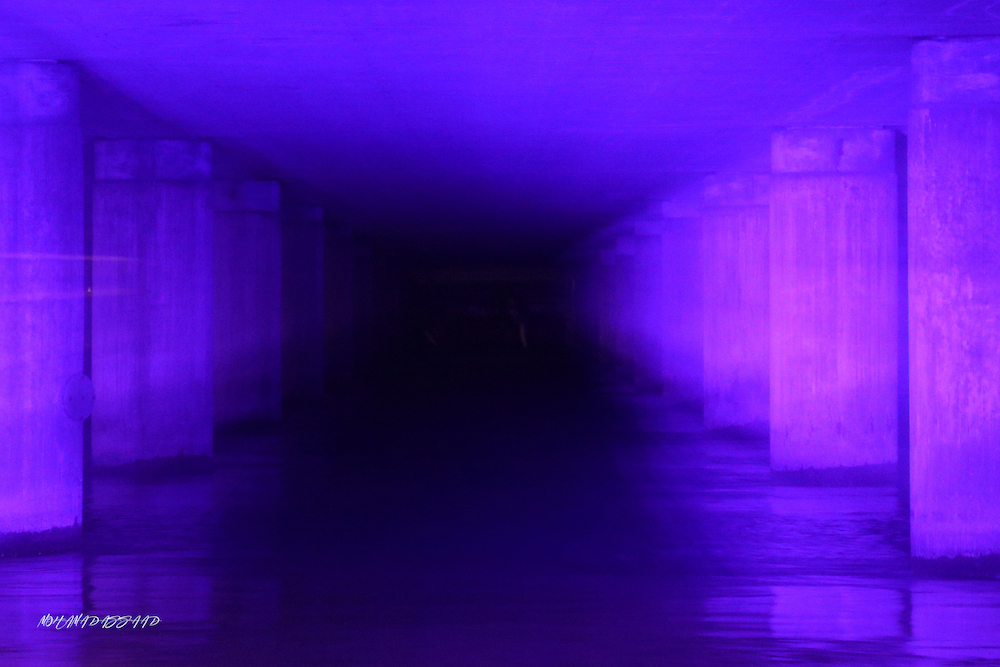
The winning image. Photo: Mohamad Assaad
“I am really pleased that so many people took the opportunity to go out into the December cold to visit our light festival,” says Erika Lanner, Director of the Nobel Prize Museum. “It has also been incredibly inspiring to see all the amazing images submitted to our photo contest.”
This year’s contest winner, Mohamad Assaad chose to photograph the work [re|in]verse by Jaime Reyes and the collective re|thread, which was located under Centralbron, a 1.2 km long highway bridge over Lake Mälaren connecting the northern and southern districts of central Stockholm. The work visualises what happens inside scientists’ computers when they work with complex data. The inspiration came from laureate Werner Heisenberg. In 1932, Heisenberg was awarded the Nobel Prize in Physics for modelling quantum mechanics, which was then an emerging field of research. He worked with matrices, which are powerful but complex mathematical tools.
Mohamad Assaad interpreted the artwork as a light in the darkness.
“The artwork radiated something deep, dark and unknown while being surrounded by a hopeful light,” says Mohamad Assaad. “It was not so easy to photograph. I had to stand for a long time to capture the right mood.”
Mohamad Assaad has studied media and has been working as a freelance photographer for various newsrooms since 2014.
“I am very proud about winning this contest,” says Mohamad Assaad. “It means a lot to me. The Nobel Prize is iconic. It symbolises success and appreciation for the greatest scientists, thinkers and others who work for the greatest benefit to humankind. Their accomplishments make me want to try even harder to achieve even better results.”
His interest in photography was sparked at an early age by his father, who also worked as a photographer and journalist. He took his first photo when he was seven years old. His father taught him not to just snap a bunch of pictures and hope for the best. Instead, it is important to take in your surroundings and wait for the right moment.
“For me, photography is like memory. It is history and heritage that is passed on from one generation to another, smoothly and silently, without words to explain,” says Mohamad Assaad.
Since it was launched in 2020, the Nobel Week Lights festival has attracted more and more Stockholm residents and visitors to venture out on a stroll to view its many installations. The latest count at the Stockholm City Hall showed a significant increase in visits compared to the previous year. In 2023 the number of visits to the festival was estimated at 730,000, compared to 475,000 the previous year. During the light festival, 59 guided tours were offered free of charge in six different languages, all of which quickly became fully booked. Media outlets in 25 different countries reported on the festival, and it continues to attract public engagement on social media ‒ especially involving the photo contest about capturing the artistic light installations in a creative way. Over 400 entries were received, and ten finalists were selected. The winner was chosen through a vote on the Nobel Prize Museum’s Facebook page.
Press contact
Rebecka Oxelström, Head of Press
press@nobelprize.org
+ 46 8 122 084 45
Press images are to be found at: http://nobelprize.org/press-images-nobel-week-lights-2023
About Nobel Week Lights
Nobel Week Lights was initiated and produced by Annika Levin, Alexandra Manson, Lara Szabo Greisman and Troika AB. The event is part of the Nobel Week programme and is being implemented by the Nobel Prize Museum with support from the City of Stockholm, the Stockholm Chamber of Commerce, Einar Mattsson AB, Fagerhult, FAM and Grand Hôtel Stockholm, Erling-Persson Foundation and Knut and Alice Wallenberg Foundation as well as several other partners. Employing artistic light installations, Nobel Week Lights is a tribute to the Nobel Prize laureates and their contributions to the greatest benefit to humankind.
Nobel Prize Museum
The Nobel Prize shows that ideas can change the world. The courage, creativity and perseverance of the Nobel Laureates inspire us and give us hope for the future. Films, in-depth tours, and artefacts tell the stories of the Laureates and their contributions ‘for the greatest benefit to humankind’. Based on the Nobel Prize’s unique combination of fields – natural sciences, literature and peace – we examine the greatest challenges of our time and show how we can respond to them through science, humanism and collaboration. With our exhibitions, school programmes, lectures and conversations, we at the Nobel Prize Museum strive to engage the public in making a better world. Today we are located at Stortorget in Gamla Stan, Stockholm’s Old Town district. We are planning to create a new home for our public outreach activities at Slussen in downtown Stockholm.
Disclaimer: Nobel Prize Museum is not directly or indirectly involved in the process of nominating or selecting Nobel Prize laureates. These procedures are strictly confidential and regulated by the Nobel Prize awarding institutions.
© Nobel Prize Museum 2024. Nobelpriset®, Nobel Prize® and the Nobel Prize medal are registered trademarks of the Nobel Foundation.